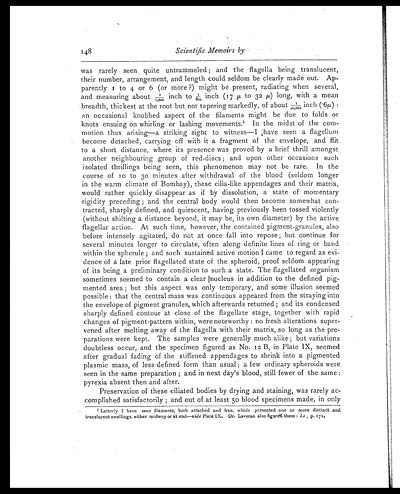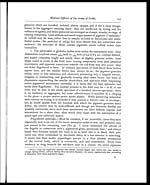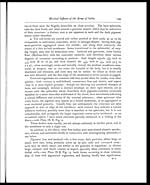Medicine - Institutions > Army health reports and medical documents > Scientific memoirs by medical officers of the Army of India > Part III, 1887 > 10 - Note on some aspects and relations of the blood-organisms in ague
(154) Page 148
Download files
Individual page:
Thumbnail gallery: Grid view | List view

148
Scientific Memoirs by
was rarely seen quite untrammeled; and the flagella being translucent,
their number, arrangement, and length could seldom be clearly made out. Ap-
parently 1 to 4 or 6 (or more ?) might be present, radiating when several,
and measuring about 1/1,500 inch to 1/800inch (17 µ to 32 µ) long, with a mean
breadth, thickest at the root but not tapering markedly, of about 1/40,000 inch (6µ):
an occasional knobbed aspect of the filaments might be due to folds or
knots ensuing on whirling or lashing movements. 1In the midst of the com-
motion thus arising—a striking sight to witness—I have seen a flagellum
become detached, carrying off with it a fragment of the envelope, and flit
to a short distance, where its presence was proved by a brief thrill amongst
another neighbouring group of red-discs; and upon other occasions such
isolated thrillings being seen, this phenomenon may not be rare. In the
course of 10 to 30 minutes after withdrawal of the blood (seldom longer
in the warm climate of Bombay), these cilia-like appendages and their matrix,
would rather quickly disappear as if by dissolution, a state of momentary
rigidity preceding; and the central body would then become somewhat con-
tracted, sharply defined, and quiescent, having previously been tossed violently
(without shifting a distance beyond, it may be, its own diameter) by the active
flagellar action. At such time, however, the contained pigment-granules, also
before intensely agitated, do not at once fall into repose; but continue for
several minutes longer to circulate, often along definite lines of ring or band
within the spherule; and such sustained active motion I came to regard as evi-
dence of a late prior flagellated state of the spheroid, proof seldom appearing
of its being a preliminary condition to such a state. The flagellated organism
sometimes seemed to contain a clear |nucleus in addition to the defined pig-
mented area; but this aspect was only temporary, and some illusion seemed
possible: that the central mass was continuous appeared from the straying into
the envelope of pigment granules, which afterwards returned; and its condensed
sharply defined contour at close of the flagellate stage, together with rapid
changes of pigment-pattern within, were noteworthy: no fresh alterations super-
vened after melting away of the flagella with their matrix, so long as the pre-
parations were kept. The samples were generally much alike; but variations
doubtless occur, and the specimen figured as No. 12 B, in Plate IX, seemed
after gradual fading of the stiffened appendages to shrink into a pigmented
plasmic mass, of less defined form than usual; a few ordinary spheroids were
seen in the same preparation; and in next day's blood, still fewer of the same:
pyrexia absent then and after.
Preservation of these ciliated bodies by drying and staining, was rarely ac-
complished satisfactorily; and out of at least 50 blood specimens made, in only
1Latterly I have seen filaments, both attached and free, which presented one or more distinct and
translucent swellings, either midway or at end—vide Plate IX. Dr. Laveran also figured them: l.c , p. 171.
Set display mode to: Large image | Zoom image | Transcription
Images and transcriptions on this page, including medium image downloads, may be used under the Creative Commons Attribution 4.0 International Licence unless otherwise stated. ![]()
| Permanent URL | https://digital.nls.uk/75004468 |
|---|
| Shelfmark | IP/QB.10 |
|---|---|
| Additional NLS resources: | |




